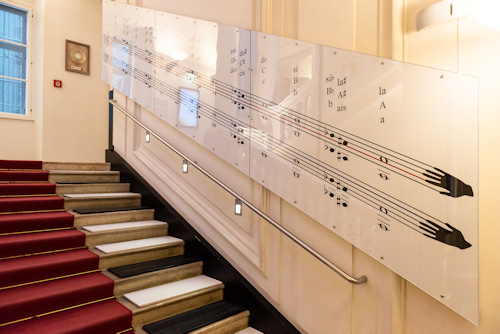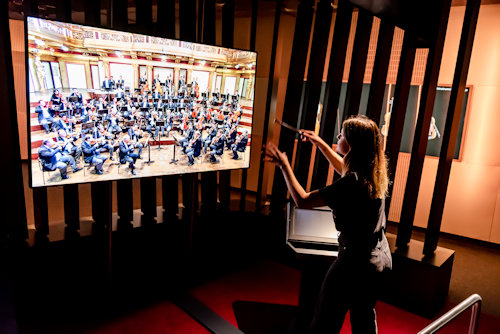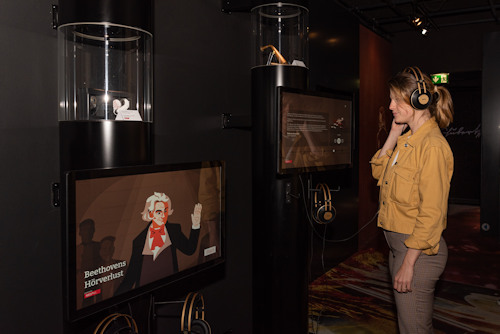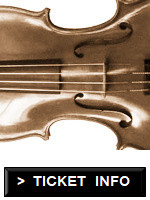A house of music in the city of music…Vienna’s Haus der Musik is a unique experience, like a cross between a musical history museum and a homage to Kubrick.
- Presents Vienna’s great composers
- Futuristic displays also tackle the wider concept of “sound”
- Includes the Wiener Philharmoniker orchestra museum
- Full of interactive exhibits (good for kids)
- For example: conduct the Philharmoniker
- Book Haus der Musik tickets*
- See also:
- Composer trails in Vienna
- Concert suggestions for visitors
- Vienna’s Museums
The House of Music

(Located in the former early 19th-century Erzherzog-Carl-Palais)
The Haus der Musik takes you on two journeys.
The first introduces you to some of the greats of classical music in Vienna.
One floor, for example, presents the story of the Wiener Philharmoniker orchestra (whose founder lived in this very house) with numerous items of memorabilia. On my visit, you could also watch extended passages from the orchestra’s most recent New Year’s Concert and Summer Night Concert.
Another floor dedicates a room each to various famous composers associated with the city: Beethoven, Mozart, Haydn, Schubert, Strauss (II) and Mahler.
Others, like Brahms, get their own little display cabinets.

(The musical staircase works like a piano; press photo courtesy of the HdM © Hanna Pribitzer)
The second journey examines the concept of sound with a range of interactive experiences.
One floor, for example, is almost futuristic in design, exploring the meaning, science, perception and creation of sounds in a series of audiovisual and VR environments.
So what caught my eye (and ear)?
Highlights for visitors
If you like musical memorabilia, prepare for a feast.
The Haus der Musik’s composer rooms feature, for example, biographical details and documents, instruments from the time and (mainly copies of) original sheet music.
Many personal items belonging to conductors and musical geniuses serve to build direct connections to the past. For example:
- Batons belonging to Richard Strauss, Herbert von Karajan, and others (some clearly wielded with dramatic emphasis, going by the damage)
- Leonard Bernstein’s tailcoat
- Brahms’ reading glasses and ink pen: imagine what notes must have tumbled out of its nib
- Talking of glasses, how about a pair of Schubert’s and a pair belonging to Strauss?
- The original conductor’s score for the Marriage of Figaro with Mahler’s handwritten annotations from 1897
- The entrance door to Beethoven’s last home
- A fascinating copy of the title page to the manuscript copy of Beethoven’s 3rd Symphony (Eroica). He crossed out the original dedication to Napoleon with some vehemence

(Conduct the Wiener Philharmoniker; press photo courtesy of the HdM © Hanna Pribitzer)
The Haus der Musik’s interactive elements are a lot of fun and should also keep kids happy. For example:
- Create your own unique waltz by rolling four virtual dice four times each
- One set of stairs in the house doubles as a piano, where each step plays a note. You can’t help but try it out
- Conduct the Vienna Philharmonic Orchestra as they play six well-known pieces
For reasons I can’t explain, I absolutely loved conducting the Philharmonic: waving the baton furiously as one of the world’s greatest orchestras played The Radetzky March.
Too furiously it seems. The orchestra stopped after a few moments, and one disappointed musician stood up to admonish me for conducting like I was wielding a light sabre.

(Trace the development of Beethoven’s hearing loss; press photo courtesy of the HdM © Hanna Pribitzer)
- A VR experience where you create your own CLONG (sound creature) and then relax beneath a CLONG-filled soundscape
- A 3-part installation that guides you through a timeline of Beethoven’s loss of hearing, with touchscreens, audio, and the medical background, too
- Let Mozart put your name to music: he defined musical associations with each letter of the alphabet
Across 2025, expect all the composer rooms to undergo sequential modernisation to introduce ever more virtual installations and innovative displays.
And sound always fills the Haus der Musik almost everywhere, whether the twitterings of birds or the famous compositions of those giants of classical music.
Tickets & visitor tips
(Booking service provided by Tiqets.com*, who I am an affiliate of)
Some things to note:
- All information displays, exhibit labels, screen text etc. I saw were in both German and English
- The museum is one of the rare ones with late opening, making it a strong candidate as an evening activity
- Various delights fill the Haus der Musik shop. As well as the expected (CDs, books, etc.), be prepared for the likes of musical socks and cufflinks, or musical pasta shapes
- Visitors tend to gather around the interactive elements. During busy seasons, you may have to wait to wave your baton at the first violin of the Vienna Philharmonic Orchestra. At such times, I suggest you go early or late in the day
- For more VR or interactive & immersive experiences in Vienna, try these suggestions
- For more on all those famous composers, look for the musician locations run by the Wien Museum, the Mozarthaus and Mythos Mozart (both not far from the Haus der Musik) and the House of Strauss (large interactive exhibition plus concert opportunities)
- For even more on the city’s classical heritage, try these guides to places in Vienna associated with the lives and music of Beethoven, Mozart, Haydn, etc.
How to get to the Haus der Musik
The Haus der Musik is very central, not far from the common tourist routes.
Subway: just a short walk from Karlsplatz station (U1, U2 and U4 lines – look for the Oper exits), Stadtpark (U4) and Stephansplatz (U1 and U3).
Tram/bus: take trams 2, 71 or D around the Ring to Schwarzenbergplatz, then walk down Schwarzenbergstraße. Or bus 2A to Schwarzenbergplatz or Kärntner Straße
Address: Seilerstätte 30, 1010 Vienna | Website
